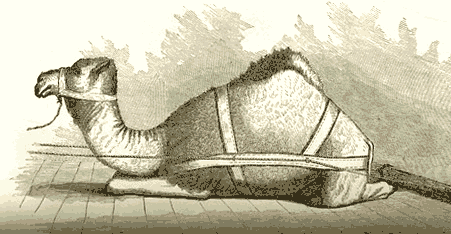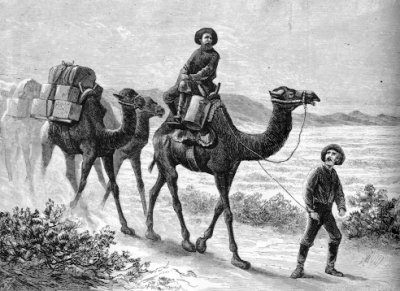Dromedaries in Texas
Today, an ecological experiment leaves hardly a trace. The University of Houston's College of Engineering presents this series about the machines that make our civilization run, and the people whose ingenuity created them.
Long before Jefferson Davis became president of the Confederacy, he served in the Mexican-American War. He knew how daunting the dry Southwest can be, when your only vehicle is a horse.
In 1853, as Secretary of War, Davis proposed that dromedary camels might replace horses in the American desert. The idea wasn't original. George Perkins Marsh had suggested it in 1847.
Marsh was a brilliant figure in American politics and letters. He fathered our environmental movement. He served in Congress and as our minister to Italy. Almost incidentally, he started the field of structural linguistics, as well.
In 1848, Marsh and Davis served on the Smithsonian Institution's Executive Committee. Two years later Marsh traveled Egypt and the Holy Land on camels. He almost died of disease, but he came back surer than ever that camels could serve the military.
Finally, in 1855, Marsh gave a Smithsonian lecture on the camel. He had Congress's attention. The next year Davis got his camels. Thirty-three of them arrived at Indianola, Texas, on April 29, 1856. Forty-one more showed up a year later.
Marsh had written accurately about the camel. He really had predicted the course of the experiment. They could carry greater loads than horses. They had far better endurance. They were also smelly, disagreeable beasts. They didn't domesticate well. They'd do just fine in the Wild West. But you wouldn't want them around once you'd created civilization.
We set up our camel cavalry at Camp Verde in the Texas Hill Country. At first the soldiers hated the camels. Some actually killed them in anger. They terrified horses. Indians stole some. Others just wandered off. But the soldiers got the hang of them.
Camels could travel 90 miles a day. They fit into the Texas frontier. Then, during the Civil War, the South captured the camels. They used them to haul cotton into Mexico.
Afterward, railroads and settlements came to Texas. Camels became an inconvenient curiosity. The Army finally sold them off to a large circus. For years after, stray camels turned up here and there in the American outback.
I couldn't find out how close Jefferson Davis and Marsh had been before the Civil War. But when it was over, Marsh advocated two things. One was that Davis be hanged. The other was that freed slaves should be given the vote immediately.
But for a season their camels had delighted children and terrified horses. They'd given the army a whole new face. Then they vanished utterly. And today those great lurching beasts seem as far from our life in Texas as some myth about dragons.
I'm John Lienhard, at the University of Houston, where we're interested in the way inventive minds work.
(Theme music)
Lowenthal, D., George Perkins Marsh: Versatile Vermonter. New York: Columbia University, 1958.
Emmett, C., Texas Camel Tales. San Antonio, TX: Naylor Printing Co., 1933.
Marsh, G.P., The Camel -- his Organization Habits and Uses. Boston: Gould and Lincoln, 1856, (for material on importing the camel to America, see Chapters XVII, XVIII, and Appendix D).
Marsh, G.P., Man and Nature. Cambridge: The Harvard University Press, 1965. (This is an annotated reprint of the original 1864 edition.)
Marsh, G.P., The Earth as Modified by Human Action: A Last Revision of Man and Nature. New York: Charles Scribner's Sons, 1885.
Marsh, G.P., Lectures on the English Language. New York: Charles Scribner's Sons, 1859, 1884, 1887.
Indianola, Texas, is a town just inside the southern tip of Matagorda Peninsula -- half way between Corpus Christi and Galveston on the Gulf Coast.

Image courtesy of Special Collections, University of Houston Library
A camel from an 1855 U.S. War Department bulletin, The Purchase, Importation, and Use of Camels and Dromedaries to be Employed for Military Purposes

From the 1877 Harper's Weekly Magazine
Camels in Nevada delivering military supplies from San Antonio to Los Angeles in 1857